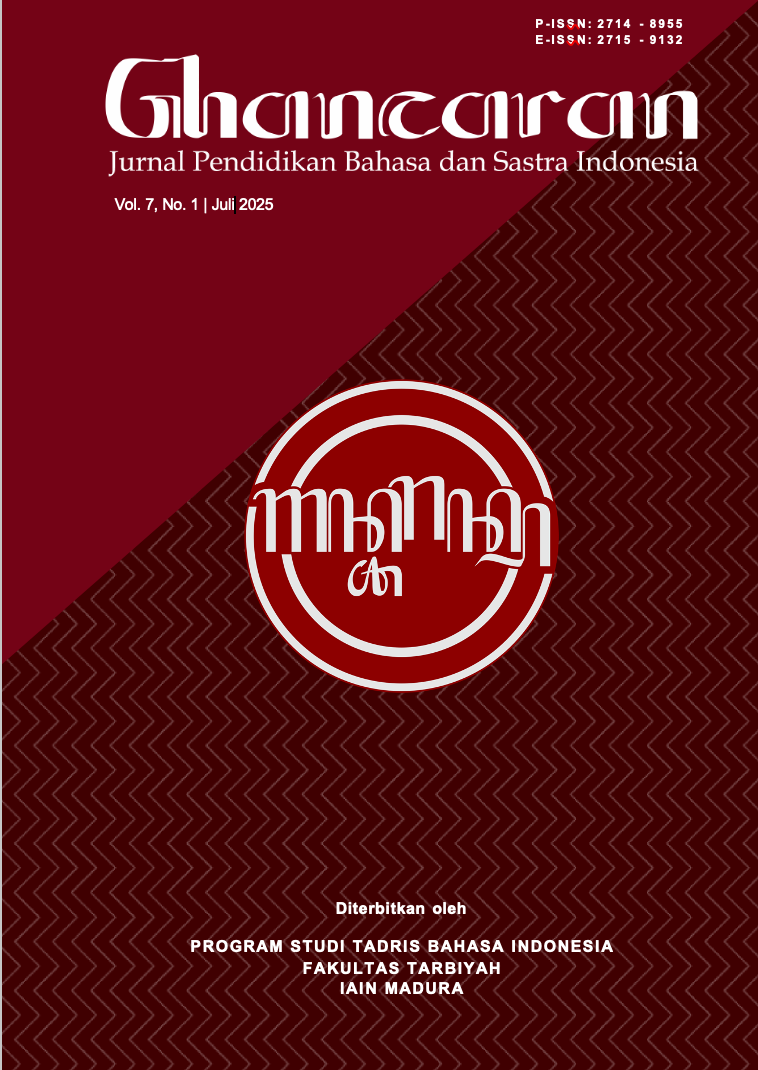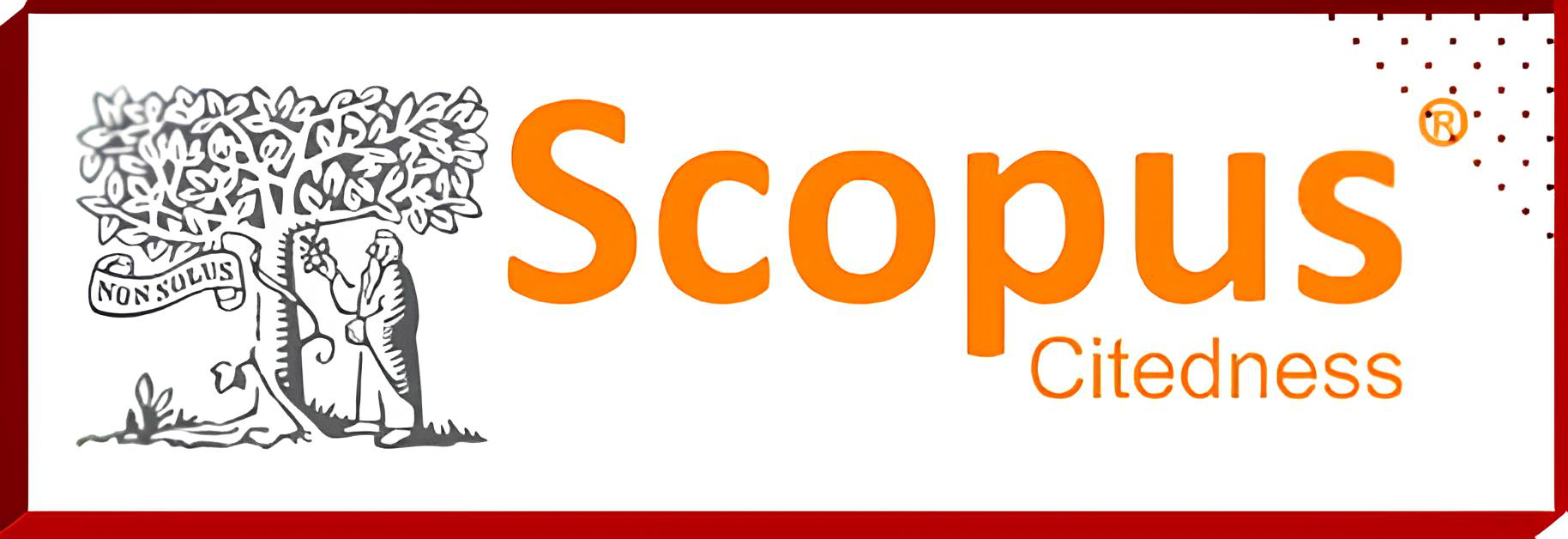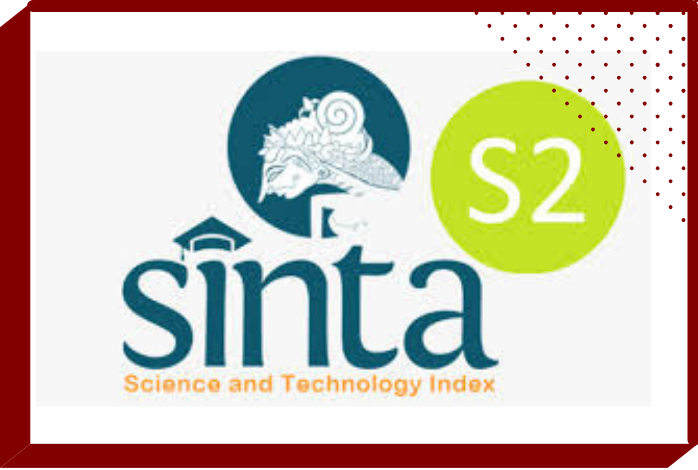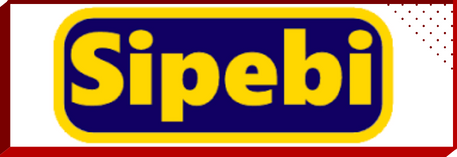Integrating Mobile Learning and BOM ATOM Model in Teaching Observational Report Texts at Vocational High Schools
 Abstract views: 1522
,
Abstract views: 1522
,
 PDF downloads: 116
PDF downloads: 116
Abstract
This study aims to describe the application of mobile learning Tangkas Berobservasi model BOM ATOM in learning to write observation report text in class X SMK. The rapid advances of technology in the learning process require students to have digital literacy which is not only the ability to operate devices, but also the skills in understanding, using, and critically interacting with information and communication technology. In the context of learning, mobile learning is one of the innovative solutions that allows flexible access to materials anytime and anywhere. The implementation of Mobile learning Tangkas Berobservasi based on the BOM ATOM model in learning observation report text in vocational is one of the learning solutions with technology integration. This media is designed to develop students' critical, analytical, and collaborative thinking skills through the use of digital technology. This research uses a qualitative approach with interview and observation methods as data sources. The results showed that the use of Android-based Tangkas Berobservasi mobile learning is suitable for students' needs and able to improve digital literacy. In addition, this technology-based learning provides convenience in accessing materials, improving concept understanding, and supporting digital interaction and collaboration in the learning process. The implementation of BOM ATOM model in mobile learning also helps students in organizing information, developing reflective skills, and increasing active participation in learning.
Downloads
References
Afrizal. (2016). Metodelogi Penelitian Kualitatif. Jakarta: Rajawali Press.
Ahdan, S., Putri, A. R., & Sucipto, A. (2020). Aplikasi M-learning sebagai Media Pembelajaran Conversation pada Homey English. SISTEMASI: Jurnal Sistem Informasi, 9(3), 493-509.
Akbar, A., & Noviani, N. (2019). Tantangan dan Solusi dalam Perkembangan Teknologi Pendidikan di Indonesia. In Prosiding Seminar Nasional Program Pascasarjana Universitas PGRI Palembang.
Al-Rahmi, A. M., Al-Rahmi, W. M., Alturki, U., Aldraiweesh, A., Almutairy, S., & Al-Adwan, A. S. (2022). Acceptance of Mobile Technologies and M-learning by University Students: An Empirical Investigation in Higher Education. Education and Information Technologies, 27(6), 7805-7826.
Anisah, D. (2023). Penggunaan Media Pembelajaran Bahasa Indonesia. Malang: Madza Media.
Ardiansyah, A. A., & Nana, N. (2020). Peran Mobile Learning sebagai Inovasi dalam Meningkatkan Hasil Belajar Siswa pada Pembelajaran di Sekolah. Indonesian Journal of Educational Research and Review, 3(1), 47-56.
Bahari, A., Maulipaksi, D., Putri, R. H., Retnawati, D., Anugrahmawaty, D., Sari, P., Kusuma, A., Pramudita, P., Sugianto, D., Indriaswarti, I., & Widianto, N. (2019). Media Komunikasi dan Inspirasi: JENDELA Pendidikan dan Kebudayaan XXXVIII/Oktober 2019.
Bandura, A. (1986). Social Foundations of Thought and Action: A Social Cognitive Theory. Englewood Cliffs, NJ: Prentice-Hall.
Black, P., & Wiliam, D. (1998). Assessment and Classroom Learning. Assessment in Education: Principles, Policy & Practice, 5(1), 7-74.
Boonmoh, A., Jumpakate, T., & Karpklon, S. (2022). A Close Look at the Use of Technology by Thai Teachers in Secondary EFL Classrooms. Computer-Assisted Language Learning Electronic Journal, 23(1), 78-107.
Cahyono, B. Y., & Astuti, U. P. (2019). Effect of Process Writing Approach Combined with Video-Based Mobile Learning on Indonesian EFL Learners' Writing Skill across Creativity Levels. International Journal of Instruction, 12(3), 325-340.
Crompton, H., & Burke, D. (2018). The Use of Mobile Learning in Higher Education: A Systematic Review. Computers & Education, 123, 53-64.
Deterding, S., Dixon, D., Khaled, R., & Nacke, L. (2011). From Game Design Elements to Gamefulness. In Proceedings of the 15th International Academic MindTrek Conference (pp. 9–15).
El-Sofany, H., & El-Haggar, N. (2020). The Effectiveness of Using Mobile Learning Techniques to Improve Learning Outcomes in Higher Education. International Journal of Interactive Mobile Technologies (iJIM), 14(8), 4-18
Escueta, M., Quan, V., Nickow, A. J., & Oreopoulos, P. (2017). Education Technology: An Evidence-based Review. Cambridge: National Bureau of Economic Research.
Fathoni, A., Prasodjo, B., Jhon, W., & Zulqadri, D. M. (2023). Media dan Pendekatan Pembelajaran di Era Digital: Hakikat, Model Pengembangan, dan Inovasi Media Pembelajaran Digital. Purbalingga: Eureka Media Aksara.
Fleming, N., & Baume, D. (2006). Learning Styles Again: VARKing up the Right Tree!. Educational Developments, 7(4), 4-7.
Grabe, W., & Kaplan, R. B. (2014). Theory and Practice of Writing: An Applied Linguistic Perspective. New York: Routledge.
Haleem, A., Javaid, M., Qadri, M. A., & Suman, R. (2022). Understanding the Role of Digital Technologies in Education: A Review. Sustainable Operations and Computers, 3, 275-285.
Hamari, J., Koivisto, J., & Sarsa, H. (2014). Does Gamification work?—a Literature Review of Empirical Studies on Gamification. In 2014 47th Hawaii international conference on system sciences (pp. 3025-3034). IEEE.
Hasan, M., Khasanah, B. A., Patriyani, R. E. H., Hidayati, H. T., Ridha, Z., Umami, R., Rahmah, N., Astuti, R., Harahap, T.K., & Mulati, T. S. (2021). Pengembangan Media Pembelajaran. Sukoharjo: Penerbit Tahta Media.
Hasanudin, C., Subyantoro, S., Zulaeha, I., Pristiwati, R. (2021). Strategi Menyusun Bahan Ajar Inovatif Berbasis Mobile Learning untuk Pembelajaran Mata Kuliah Keterampilan Menulis di Abad 21. Prosiding Seminar Nasional Pascasarjana, 2021, 343-347.
Hidayatullah, M. T., Asbari, M., Ibrahim, M. I., & Faidz, A. H. H. (2023). Urgensi aplikasi Teknologi dalam Pendidikan di Indonesia. Journal of Information Systems and Management (JISMA), 2(6), 70-73.
Hsieh, H. F., & Shannon, S. E. (2005). Three Approaches to Qualitative Content Analysis. Qualitative Health Research, 15(9), 1277-1288.
Iswanto, J., & Amin, M. N. (2023). Pemberdayaan Administrasi Pengelolaan Kelas Madrasah Diniyah Kabupaten Nganjuk. Ngaliman: Jurnal Pengabdian Masyarakat, 2(1), 69-76.
Khasanah, U., & Herina, H. (2019). Membangun Karakter Siswa Melalui Literasi Digital dalam Menghadapi Pendidikan Abad 21 (Revolusi Industri 4.0). Prosiding Seminar Nasional Program Pascasarjana Universitas PGRI Palembang, 2019, 999-1015.
Kiswanto, H. (2022). Pemanfaatan Teknologi Informasi dalam Pendidikan Masa Kini. Accessed from: https://sevima.com/pemanfaatan-teknologi-informasi-dalam-pendidikan-masa-kini/ on 12 February 2025.
Kosasih, E. (2013). Cerdas Berbahasa Indonesia untuk SMA/MA Kelas X. Jakarta: Erlangga
Kukulska-Hulme, A., & Shield, L. (2008). An Overview of Mobile Assisted Language Learning: From Content Delivery to Supported Collaboration and Interaction. ReCALL, 20(3), 271-289.
Kurniawati, E., Luthfiyah, A., Perwitasari, S., Mawarsih, P. B., & Efendi, A. N. (2024). Debates in Design and Technology Education: by Alison Hardy, New York, Routledge, Second Edition. Technology Analysis & Strategic Management, 1–2.
Kurniawati, E., Pairin, U., Indarti, T., Efendi, A. N., & Prakoso, Y. A. (2024). Digital Literacy Assisted by Mobile Learning Based on Articulate Storyline in Learning to Understand Poetry. Jurnal Teknologi Pendidikan: Jurnal Penelitian dan Pengembangan Pembelajaran, 9(3), 402-410.
Kusum, J. W., Akbar, M. R., & Fitrah, M. (2023). Dimensi Media Pembelajaran (Teori dan Penerapan Media Pembelajaran pada Era Revolusi Industri 4.0 Menuju Era Society 5.0). Jambi: PT. Sonpedia Publishing Indonesia.
Lave, J., & Wenger, E. (1991). Situated Learning: Legitimate Peripheral Participation. Cambridge: Cambridge University Press.
Maxwell, T. W. (2012). Assessment in Higher Education in the Professions: Action Research as an Authentic Assessment Task. Teaching in Higher Education, 17(6), 686-696.
Mishra, P., & Koehler, M. J. (2006). Technological Pedagogical Content Knowledge: A Framework for Teacher Knowledge. Teachers College Record, 108(6), 1017-1054.
Naveed, Q. N., Choudhary, H., Ahmad, N., Alqahtani, J., & Qahmash, A. I. (2023). Mobile Learning in Higher Education: A Systematic Literature Review. Sustainability, 15(18), 1-22.
Nisa, S. R., Kurniawati, E., Kustyamegasari, A., Nurussobah, A., & Efendi, A. N. (2025). Technology Innovation: Models, Dynamics, and Processes: by Angelo Bonomi, Boca Raton. Technology Analysis & Strategic Management, 1-3
Ozdamli, F., & Cavus, N. (2011). Basic Elements and Characteristics of Mobile Learning. Procedia-Social and Behavioral Sciences, 28, 937-942.
Pratama, P. M., Efendi, A. N., & Umami, E. E. (2022). Design and Development ILMOO: MOOC for Indonesian Language in High School. In Proceedings of the 7th International Conference on Sustainable Information Engineering and Technology, 228-232.
Pratama, P. M., Efendi, A. N., Mufarrikoh, Z., & Sholihin, M. D. I. (2022). Validation of Augmented Reality Prototype for Aspects of Cultural Learning for BIPA Students. In Conference on Innovative Technologies in Intelligent Systems and Industrial Applications (pp. 81-89). Cham: Springer Nature Switzerland.
Rosiva, S. S., Kuswandi, D., & Soepriyanto, Y. (2022). Readiness Toward M-learning Implementation During Pandemic: Secondary High School Teachers and Student’s Perception. Jurnal Penelitian Ilmu Pendidikan, 15(2), 128-136.
Rosnaeni, R. (2021). Karakteristik dan Asesmen Pembelajaran Abad 21. Jurnal Basicedu, 5(5), 4341–4350.
Saputra, H. D., Ismet, F., & Andrizal, A. (2018). Pengaruh Motivasi terhadap Hasil Belajar Siswa SMK. INVOTEK: Jurnal Inovasi Vokasional dan Teknologi, 18(1), 25–30.
Sari, R. M. M., & Priatna, N. (2020). Model-Model Pembelajaran di Era Revolusi Industri 4.0 (E-Learning, M-Learning, AR-Learning dan VR-Learning). Biormatika: Jurnal Ilmiah Fakultas Keguruan dan Ilmu Pendidikan, 6(1), 107-115.
Selwyn, N. (2012). Education in a Digital World: Global Perspectives on Technology and Education. New York: Routledge.
Sodiq, S. (2015). Developing Language Learning Textbooks Enriched with Sense of Literacy: The Case of Junior High School in Indonesia. International Education Studies, 8(9), 120–130.
Sugiyono. (2012). Metode Penelitian Pendidikan. Bandung: Alfabeta.
Tondeur, J., Scherer, R., Baran, E., Siddiq, F., Valtonen, T., & Sointu, E. (2019). Teacher Educators as Gatekeepers: Preparing the Next Generation of Teachers for Technology Integration in Education. British Journal of Educational Technology, 50(3), 1189-1209.
Viberg, O., & Grönlund, Å. (2013). Cross-Cultural Analysis of Users' Attitudes Toward the Use of Mobile Devices in Second and Foreign Language Learning in Higher Education: A Case from Sweden and China. Computers & Education, 69, 169-180.
Vygotsky, L. S., & Cole, M. (1978). Mind in Society: Development of Higher Psychological Processes. Cambridge: Harvard University Press.
Warsita, B. (2010). Mobile Learning sebagai Model Pembelajaran yang Efektif dan Inovatif. Jurnal Teknodik, 14(1), 62-73.
Wicaksono, S. R., Lubis, M. S. A., Suprapto, E., Khasanah, K., & Ulimaz, A. (2021). Improvisation of Project Based Learning with Combination of Collaborative Learning as Rapid Response to Pandemic Learning. Jurnal Iqra': Kajian Ilmu Pendidikan, 6(2), 215-224.
Widyatama, A., & Pratama, FW (2022). Pengembangan Mobile learning PINTHIR Berbasis Android sebagai Sumber Belajar dan Sarana Mengerjakan Soal Trigonometri SMA. Mosharafa: Jurnal Pendidikan Matematika, 11 (1), 25-36.
Zamahsari, G. K., Putikadyanto, A.P.A, Amin, M. B., Efendi, A. N., Effendy, M. H., & Adiebia, I. C. (2023, January). Pedatren: Educational Administration Applications for Simplifying Paiton Probolinggo's Nurul Jadid Islamic Boarding School's Management. In 2023 17th International Conference on Ubiquitous Information Management and Communication (IMCOM) (pp. 1-5). IEEE.
Copyright (c) 2025 GHANCARAN: Jurnal Pendidikan Bahasa dan Sastra Indonesia

This work is licensed under a Creative Commons Attribution-ShareAlike 4.0 International License.
Ghancaran: Jurnal Pendidikan Bahasa dan Sastra Indonesia uses an Open Access Policy under the Creative Commons Attribution-ShareAlike 4.0 International License. Authors publishing in this journal agree to the following terms:
- Ghancaran Journal holds the copyright and grants the journal rights for first publication with the work simultaneously licensed under a

The work is distributed under Creative Commons Attribution-ShareAlike 4.0 International License which allows others to share, copy, and redistribute the material in any media or format and adapt, remix, change, and develop the material even for commercial purposes, as long as it is stated credit and license derivative works under similar terms. - Authors may make additional contractual arrangements for non-exclusive distribution of the journal's published work version.
- Authors are permitted to post their work online (e.g., in institutional repositories or on their websites) before and during submission, as doing so may lead to productive exchange.



















